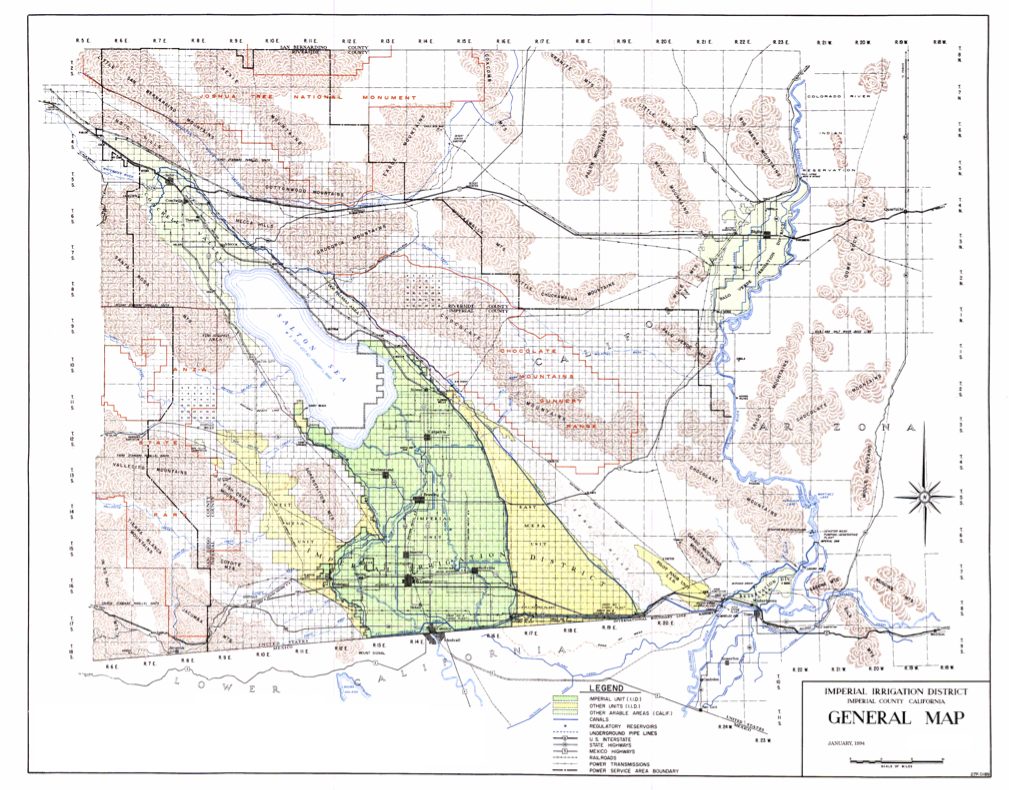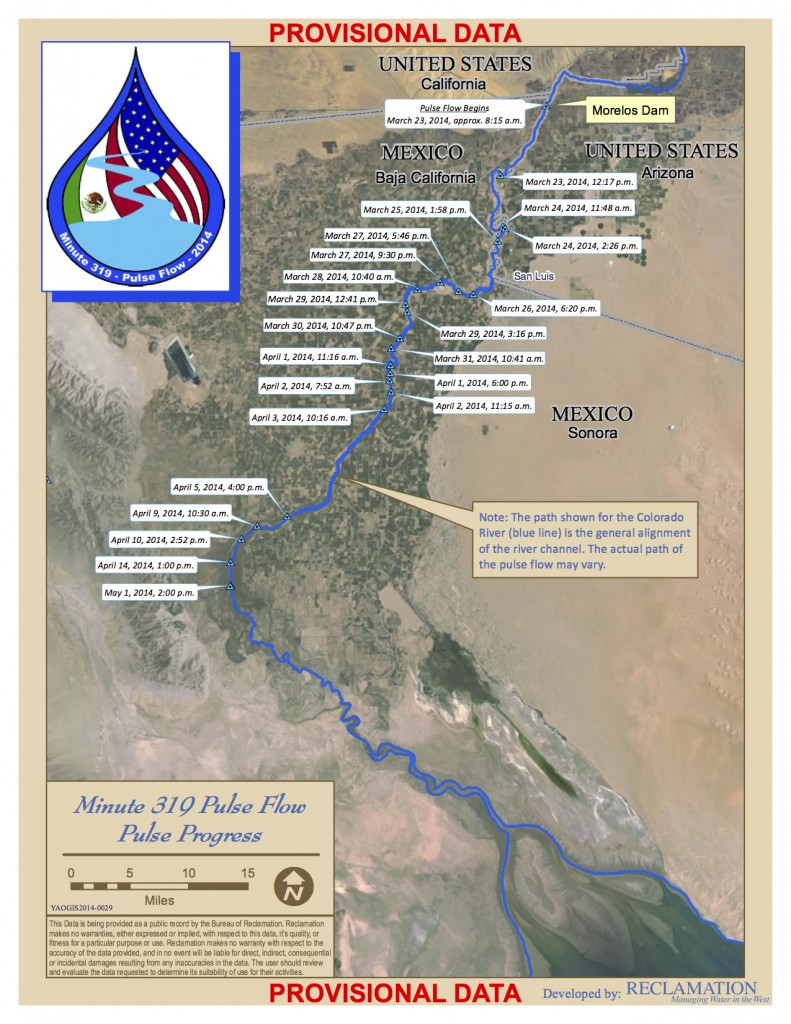New Mexico’s current drought, with dwindling water supplies and increasing wildfire risk, is a taste of our future under climate change, according to a sweeping new federal report released Tuesday.
While climate’s natural ups and downs are playing a major role in our current drought, rising greenhouse gases increase the odds of conditions like New Mexico is now experiencing, according to the National Climate Assessment.
Getting my own little pulse flow
It’s lacking the drama of the March Minute 319 pulse flow on the Colorado River, but I’m getting my own little pulse flow on the Rio Grande here in Albuquerque beginning later this week:
Beginning Wednesday, central New Mexico will get its river back – for a week.
The anemic Rio Grande, parched by drought, will get a shot of extra water, a simulated spring runoff peak, to try to nurse along the dwindling population of endangered Rio Grande silvery minnows.
JR’s garden
I like my friend JR’s attitude toward gardening in the desert:
I water almost nothing here. I do throw yesterday’s left over water from Cooper’s bowl on the autumn sage. It keeps the red blossoms coming and the hummingbirds like that. Some days the birds get the left over water. The New Mexico locust gets dishwater. That’s it. They grow slowly, but the Arizona ash, the New Mexico olive, the Apache plume, the Mongolian whatever it is, the lilac and the rest seem to do fine on their own.
With Colorado River water, growing Brussels sprouts
Imperial County in the desert of southeastern California is the nation’s leading producer of Brussels sprouts.
According to the newly released U.S. Department of Agriculture Census of Agriculture, there were 2,237 acres of Brussels sprouts in Imperial in 2012, growing on 6 farms. For reasons unknown to me (c’mon, you’ve tried ’em, right?) Brussels sprouts are growing in popularity, with total U.S. acreage up from 3,874 in 2007 to 7,586 in 2012, most of them shipped direct to market. In 2007, Brussels sprouts acreage in Imperial on just two farms was so small that it wasn’t disclosed. Lissa points out that Trader Joe’s sells Brussels sprouts on the stalk as a decorative item. Maybe that explains the Brussels sprouts boom?
I say this not because of a particular fascination with Brussels sprouts (c’mon, you’ve tried ’em, right?), but rather because if I want to understand water in the Colorado River Basin, I have to understand farm water use in the Colorado River Basin. If I want to understand farm water use in the Colorado River Basin, I have to understand the Imperial Valley. In 2012, Imperial’s consumptive use of Colorado River water was 2.9 million acre feet (source – pdf). By comparison, agriculture’s consumptive use in the entire Upper Colorado River Basin in 2012 was 2.9 million acre feet (source – pdf).
Some other interesting Imperial County data points from the Census of Agriculture:
- Total land in farms – 515,783 acres
- Total irrigated land – 455,033 (interestingly, that’s up from 376,535 in 2007, a 21 percent increase – what’s up with that?)
- Total market value of agricultural production: $1.9 billion, up from $1.3 billion in 2007
- Net cash farm income, after expenses: $262 million, up from $195 million in 2007, a 34 percent increase
- Total vegetable acreage (including Brussels sprouts): 126,183 acres, up from 83,486 in 2007
- Total forage acreage (alfalfa and related munchies for cows and such): 246,400, up from 229,569 in 2007, a 7 percent increase.
You can see that Brussels sprouts was a bit of misdirection here. The real lead, if I were to write a news story about this data, is that in the midst of a deep drought gripping the Colorado River Basin, the farming region that uses the biggest chunk of the river’s water has expanded its production.
Maybe that’s the lead. But here’s another data point, from the U.S. Census Bureau’s 2012 American Community Survey: in 2012, per capita income in Imperial County was $14,833, just a hair above half the California statewide number of $28,341 and the poorest county in the state by a significant margin. And while farm income and irrigated acreage and Brussels sprouts are up, Imperial County per capita income is down from $14,996 in 2007. This isn’t a simple story.
Wilkinson on the environmental shift in western water policy
The University of Colorado’s Charles Wilkinson:
One of the best developments for the environment in the West has been the quiet but deep revolution in federal water policy. Over the course of the past quarter century, we have moved from a dam-and-reservoir, build-at-any-cost mentality to a multifaceted approach that respects all that we need from, and love about, rivers.
Water in the desert: Sybil’s fountain
The Salt/Verde, climate change and Upper Basin Envy
tl;dr – Heads up, Arizona. Less water headed your way!
longer version – Stuck out here in the Rio Grande Basin, I’ve long suffered Colorado River Basin Envy Syndrome. The Colorado is the sexy river, which means it gets all the cool science. I dream of an analysis this rich of uncertainties in my river’s streamflow.
Turns out that even within the Colorado River Basin there’s a little Envy Syndrome going on:
Numerous studies have assessed the potential impacts of climate change on the upper Colorado River basin… The lower basin is relatively less well studied, due mainly to the fact that most rivers in the lower basin were dammed during the 20th century and therefore do not contribute much surface water flow to the Colorado River basin (except in very wet years). Nonetheless, Colorado River tributaries in the lower basin (including two watersheds studied in this paper) are very important from a water supply perspective, providing totally 54% of the water used in the state of Arizona. (emphasis in original)
That’s Rajagopal et al., in On physical mechanisms related to climate-induced drying of two semi-arid watersheds in the southwest US. Their key finding:
The projections of this model ensemble indicate a statistically significant 25% decrease in streamflow by the end of the 21st century. The primary cause for this change is due to projected decreases in winter precipitation accompanied by significant (temperature driven) reductions in storage of snow and increased winter evaporation. The results show that water management in central Arizona is highly likely to be impacted by changes in regional climate.
Colorado River Pulse Flow On the Move Again
After stalling out for a couple of weeks, the Colorado River Delta Minute 319 pulse flow is back on the move.
According to the latest map and missive from the science team, an earthen dam below the downstream-most habitat restoration site was removed, and the pulse has received an added stimulus from the Kilometer 27 Spillway (see nice NASA map/satellite image for the location). The KM27 release is an aspect of the critical “plumbing” aspect of this environmental restoration experiment. The main river channel, because of dry stretches with low groundwater, is not necessarily the most efficient way to get water to environmental restoration sites in the lower reaches of the delta, so some of the pulse flow water is making part of its journey through CONAGUA irrigation canals.
Irrigation and hope for New Mexico’s future

New Mexico’s appeal for statehood – greeting President Roosevelt at Albuquerque, Underwood & Underwood, c1903 June 11. Courtesy Library of Congress
Teddy Roosevelt, speaking in Santa Fe, NM, May 5, 1903, during his grand western tour:
I build no small hope upon the aid that under the wise law of Congress will ultimately be extended to this as to other States and Territories in the way of governmental aid to irrigation. Irrigation is of course to be in the future well-nigh the most potent factor in the agricultural development of this Territory and one of the factors which will do most toward bringing it up to Statehood. Nothing will count more than development of that kind in bringing the Territory in as a State. That is the kind of development which I am most anxious to see here the development that means permanent growth in the capacity of the land, not temporary, not the exploiting of the land for a year or two at the cost of its future impoverishment, but the building up of farm and ranch in such shape as to benefit the home-maker whose intention it is that this Territory of the present, this State of the future, shall be a great State in the American Union.
(I’m a little confused by the dates, but the picture appears to be from that same tour, possibly taken on the same day as his Santa Fe speech.)
Groundwater depletion in the High Plains Aquifer
Here’s a nice visualization from the USGS of groundwater depletion in the High Plains Aquifer:
h/t Sharlene Leurig



